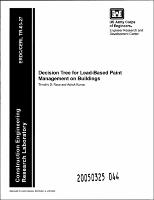Please use this identifier to cite or link to this item:
https://hdl.handle.net/11681/19645Full metadata record
| DC Field | Value | Language |
|---|---|---|
| dc.contributor.author | Race, Timothy D. | - |
| dc.contributor.author | Kumar, A. (Ashok), 1938- | - |
| dc.date.accessioned | 2016-10-12T14:02:23Z | - |
| dc.date.available | 2016-10-12T14:02:23Z | - |
| dc.date.issued | 2003-12 | - |
| dc.identifier.uri | http://hdl.handle.net/11681/19645 | - |
| dc.description | Technical Report | - |
| dc.description.abstract | Abstract: A lead hazard control decision tree was developed for buildings. The tree yields multiple outputs or decisions on 29 branches using only eight queries. This decision tree addresses both lead hazard control for child occupied buildings including family housing, childcare facilities, and schools and non-child occupied buildings such as offices, equipment, utility, storage, shop, and other non-child occupied buildings. The decision tree employs eight queries to determine a solution for a given set of circumstances. However, each question and answer is laden with significant meaning and requires the user have knowledge from the preliminary investigation of the substrate arid paint condition. The criteria presented in query format are based on strategy selection criteria combining regulatory/policy driven strategy selection criteria include: historic preservation, building occupancy, and Army policy. Technology driven selection criteria are substrate condition, paint condition, exposure, and substrate material. | - |
| dc.publisher | Construction Engineering Research Laboratory (U.S.) | - |
| dc.publisher | Engineer Research and Development Center (U.S.) | - |
| dc.relation | http://acwc.sdp.sirsi.net/client/en_US/search/asset/1002457 | - |
| dc.title | Decision tree for lead-based paint management on buildings | - |
| dc.type | Report | en_US |
| Appears in Collections: | Technical Report | |
Files in This Item:
| File | Description | Size | Format | |
|---|---|---|---|---|
| CERL-TR-03-27.pdf | 2.05 MB | Adobe PDF |  View/Open |